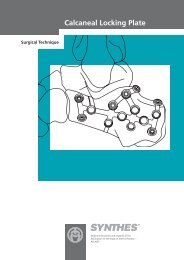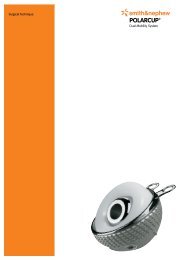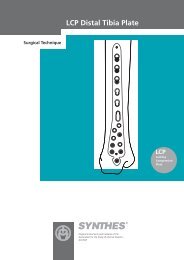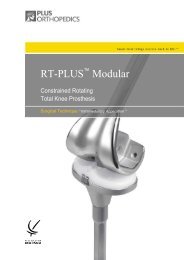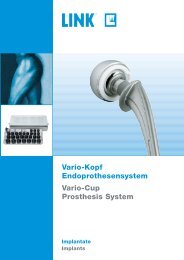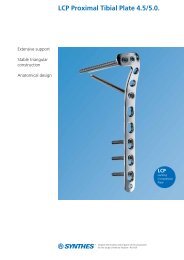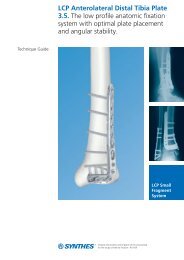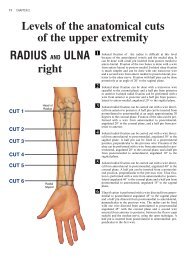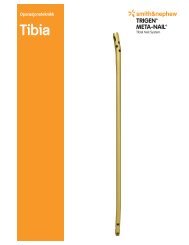Surgical Technique
Surgical Technique
Surgical Technique
Create successful ePaper yourself
Turn your PDF publications into a flip-book with our unique Google optimized e-Paper software.
TRIGEN INTERTANIntertrochanteric Antegrade Nail<strong>Surgical</strong> <strong>Technique</strong>Table of ContentsIndications ..............................................................................................2TRIGEN INTERTAN Case Examples........................................................3Design Features ....................................................................................4Implant Specifications ..........................................................................5<strong>Surgical</strong> <strong>Technique</strong> ................................................................................6Implant Selection ....................................................................................6Patient Positioning ..................................................................................6Opening the Proximal Femur................................................................8Incision and Entry Point ..........................................................................8Entry Portal Acquisition ..........................................................................9Intramedullary Reaming ........................................................................12Fracture Reduction ..................................................................................12Implant Measurement (Long Nails) ........................................................13Preparing the Canal ................................................................................13Nail Insertion..........................................................................................15Nail Assembly..........................................................................................15Insertion ..................................................................................................16Nail Anteversion ......................................................................................16Insertion Depth........................................................................................17Proximal Locking Overview......................................................................18Proximal Locking ....................................................................................20Lag Screw Drill Sleeve Insertion ..............................................................20Lag Screw Guide Pin Insertion ................................................................20Lag Screw Measurement ........................................................................21Subtrochanteric Lag Screw Insertion..................................................23No Compression......................................................................................23With Compression ..................................................................................24Cannulated Set Screw ............................................................................25Integrated Interlocking Screw Insertion..............................................27No Compression......................................................................................29With Compression ..................................................................................30Cannulated Set Screw ............................................................................31Distal Locking ........................................................................................33Short Nail ................................................................................................33Long Nail..................................................................................................33Nail Cap Insertion: Optional ....................................................................34Closure ....................................................................................................34Implant Removal ......................................................................................36Catalog Information ..............................................................................39Nota BeneThe technique description herein is made available to the healthcare professional to illustratethe author’s suggested treatment for the uncomplicated procedure. In the final analysis, thepreferred treatment is that which addresses the needs of the specific patient.1
IndicationsThe TRIGEN INTERTAN Nail is indicated forfractures of the femur, including basi/transcervical femoral neck fractures, intertrochantericand subtrochanteric fractures, ipsilateral femoralneck/shaft fractures, stable and unstable shaftfractures, segmental fractures, non-unionsand mal-unions, polytrauma, reconstructionsfollowing tumor resection and bone lengtheningand shortening.2
TRIGEN INTERTAN System Case ExamplesCase 1Preoperative AP Postoperative AP Postoperative LateralCase 2Preoperative AP Postoperative AP Postoperative Lateral3
Design FeaturesPreloaded Cannulated Set Screw allowsfor creation of a fixed angle device orfacilitates postoperative sliding4º lateral offset forminimally invasivetrochanteric entryTrapezoidal nailprofile providesenhanced stabilityin the proximalfemur for earlyweight bearingIntegrated Interlocking Lagand Compression Screws infigure eight formation forsuperior stability andlinear compressionSmall proximal diameter (15.25 x 16.25)preserves the gluteus medius tendon andthe lateral wall of the greater trochanter12º of built-in femoral neckanteversion (long nail) foroptimal screw position inthe femoral neck and headDistal locking slot allows static ordynamic locking using standard5.0mm TRIGEN Internal HexCaptured Locking Screws10mm, 11.5mm& 13mmdistal diametersClothespin distaltip reduces nailstiffness and thepotential forperiprostheticfracture distal tothe nail4
Implant SpecificationsTRIGEN INTERTAN Nail (Long)16.25mm15.25mmTRIGEN INTERTAN Nail (Short)4°15.25mm28.3mm28.3mm16.25mm18, 20cm2mAP Bow5mm10, 11.5,13mm10, 11.5,13mm40mm/18cm60mm/20cm26-46cmTRIGEN INTERTAN Lag andCompression Screws11mm40mm15mm20mmMinor diameter tapers from 11-5.6mm32mmTRIGEN INTERTANSubtrochanteric Lag Screw11mm7.8 mm7mm32mmMinor diameter tapers from 11-5.6mmSubtrochanteric Lag Screw 70-125mm15.25mmIntegrated Interlocking Screws (sold together) 70-125mmNote These views are not to scale and should be used as a pictorial representation only.5
<strong>Surgical</strong> <strong>Technique</strong>Implant SelectionThe TRIGEN INTERTAN Nail PreoperativeTemplate Set (7167-4200) may be used to assistwith preoperative implant selection. Nail size,screw length and femoral neck angle maybe determined.Note As template magnification levels areset at 117%, all measurements are estimatesof true size. All measurements must beverified intraoperatively.TRIGEN INTERTAN Nail Preoperative Template SetSet No. 7167-4200Patient PositioningPlace the patient in the supine or lateraldecubitus position on a fracture table accordingto surgeon preference and/or fracture pattern.The foot of the affected limb is placed in a footholder or a skeletal traction pin is insertedthrough the calcaneus to achieve traction. Theunaffected limb is extended down and awayfrom the affected limb or is placed up in a legholder.The torso may be abducted 10º–15º to allow forclear access to the intramedullary canal. Checkthe affected limb for length and rotation bycomparison to the unaffected limb. Rotate theC-Arm to ensure optimal AP and lateralvisualization of the proximal femur.Note If using a radiolucent table, a distractiondevice may be helpful in reducing the fracture.6
Instruments for Opening the Proximal Femur3.2mm x 343mm Tip Threaded Guide PinCat. No. 7167-4029Mini ConnectorCat. No. 7163-118612.5mm Entry ReamerCat. No. 7163-1116HoneycombCat. No. 7167-4075Entry Portal TubeCat. No. 7167-4060Entry Portal HandleCat. No. 7167-409216mm Channel Reamer*Cat. No. 7167-4062* Also available: 17mm Channel Reamer (7167-4063)7
Opening the Proximal FemurIncision and Entry PointAssemble the Honeycomb (7167-4075), EntryPortal Handle (7167-4092) and Entry Portal Tube(7167-4060). The pieces will lock in placesecurely at either 0° or 180°.A longitudinal incision is made proximalto the greater trochanter. Carry the incisionthrough to the fascia and palpate the tip ofthe greater trochanter.The optimal entry point is located on themedial face of the greater trochanter, 4° fromthe anatomical axis in the AP and in-line withthe intramedullary canal in the lateral.8
Entry Portal AcquisitionInsert the Entry Portal Instrumentation throughthe incision down to bone. Attach a 3.2mm x343mm Tip Threaded Guide Pin (7167-4029) topower via the Mini Connector (7163-1186) andinsert 2-3cm into the trochanteric region. Avoidover-insertion of the guide pin as this canestablish a false trajectory and lead to fracturemalalignment. Confirm guide pin placementin the AP and lateral planes.Note In the instance of suboptimal guide pinplacement, rotate the Honeycomb within theEntry Portal Tube to the desired location andinsert another 3.2mm guide pin.Following guide pin placement, remove theHoneycomb from the Entry Portal Tube alongwith any additionally inserted guide pins. Insertthe 12.5mm Entry Reamer (7163-1116) into the16mm Channel Reamer (7167-4062)* and attachto power. Advance the assembly through theEntry Portal Instrumentation 1-2cm into thetrochanteric region.* Also available: 17mm Channel Reamer (7167-4063)9
Adjust the angle of the reamer assembly tothe desired trajectory and advance to thepositive stop on the Entry Portal Tube. Thechannel reamer will be at the level of the lessertrochanter. If the Entry Portal Instrumentation isnot used, the channel reamer must be insertedto the level of the lesser trochanter. Confirm thereamer assembly’s final position and fracturereduction in both the AP and lateral planes.Remove the reamer assembly and guide pin.Note If inserting a long INTERTAN nail, leavethe channel reamer in place.Note In the instance of hard bone, it may benecessary to use the 17mm Channel Reamer.10
Instruments for Fracture Reduction and Intramedullary Reaming(Long Nail)Entry Portal TubeCat. No. 7167-4060Entry Portal HandleCat. No. 7167-4092RulerCat. No. 7167-407916mm Channel Reamer*Cat. No. 7167-4062GripperCat. No. 7167-4080ObturatorCat. No. 7167-4078T-HandleCat. No. 7167-4076Reamer HeadsCat. No. 7111-8231 to 7111-8256*Reamer ShaftCat. No. 7111-8200ReducerCat. No. 7167-40773.0mm x 1000mm Ball Tip Guide RodCat. No. 7163-1626* Also available: 17mm Channel Reamer (7167-4063)11
Intramedullary ReamingFracture ReductionInsert the back end of the 3.0mm Ball TipGuide Rod (7163-1626) into the front end ofthe Gripper (7167-4080) and gently close thetrigger-grip. Connect the Reducer and ReducerConnector (7167-4077) so that the words“Slot Orientation” are in line with the openingat the tip. Complete the Reducer assembly byconnecting it to the T-Handle (7167-4076).Introduce the Reducer into the intramedullarycanal through the channel reamer and EntryPortal Instrumentation. Care should be takento maintain fracture reduction. Pass the ball tipguide rod through the back of the T-Handle andinsert to the desired depth using the Reducer'scurved tip to avoid any areas of comminution.The guide rod should be center-center in the APand lateral views.Once the guide rod is in position, detachthe Gripper and remove the Reducerfrom the intramedullary canal. Slide theObturator (7167-4078) into the back of theT-Handle during extraction in order tomaintain guide rod position within the canal.12
Implant Measurement(Long Nails)After Reducer removal, re-confirm guide rodposition in the distal femur. Advance theRuler (7167-4079) over the guide rod throughthe channel reamer and Entry PortalInstrumentation. The metal tip of the Rulershould be at the level of the greater trochanter.Confirm guide rod position in the window atthe proximal end of the Ruler as shown in orderto ensure accurate implant measurement. Pushdown on the top of the Ruler until contact ismade with the guide rod. Implant length isread from the exposed calibrations near thethumbwheel on the Ruler.Note Resistance on the Ruler may be adjustedby tightening or loosening the thumbwheel.Intramedullary Reaming(Optional)Preparing the CanalBeginning with the 9.0mm End Cutting ReamerHead (7111-8231) and Flexible Reamer Shaft(7111-8200), ream the intramedullary canalsequentially in half millimeter increments to asize* 1-1.5mm larger than the selected nail size.Ensure guide rod position during reamingby inserting the Obturator into the back of theReamer unit during retraction. Continue toconfirm guide rod position throughout reaming.Periodically move the Reamer back and forth inthe canal to clear debris from the cutting flutes.Note The channel reamers will not accommodateReamer Heads larger than 12.5mm.* The largest Reamer Head that the TRIGEN Base Instrument Tray can hold is 16.0mm. Larger sizes are available in the SculptOR Reamer Set (7111-8330)13
Instruments for Nail Assembly and InsertionAlignment ArmCat. No. 7167-4066Guide BoltCat. No. 7167-4071Drill Guide HandleCat. No. 7167-4001Alignment TowerCat. No. 7167-4018T-HandleCat. No. 7167-4076Drill Guide Drop 125° & 130°Cat. No. 7167-4002 & 4003Slotted HammerCat. No. 7167-4082ImpactorCat. No. 7167-4081Guide Bolt WrenchCat. No. 7163-1140Lag Screw DrillCat. No. 7167-4040Lag Screw Drill SleeveCat. No. 7167-402314
Nail InsertionNail AssemblyAttach the Drill Guide Handle (7167-4001) to thenail with the Guide Bolt (7167-4071) and tightenwith the Guide Bolt Wrench (7163-1140) andT-Handle. The nail can only be attached to theDrill Guide Handle in one way.Attach the desired Drill Guide Drop (7167-4002,7167-4003) to the Drill Guide Handle and insertthe Lag Screw Drill Sleeve (7167-4023) into thedrop until it locks. Verify targeting accuracy bypassing the Lag Screw Drill (7167-4040) throughthe assembly. An incorrectly attached nail willnot target. Attach the Impactor (7167-4081) to theDrill Guide Handle and remove the Drill GuideDrop/Lag Screw Drill Sleeve for insertion.15
InsertionOrient the Drill Guide Handle in the lateralposition and manually advance the nail intothe proximal femur.Note Do not definitively seat the nail untilfemoral neck anteversion has been determined.Further insertion of the nail may be required toadequately seat the implant.For long nails, begin insertion with the DrillGuide Handle in the AP plane. As the nail taperreaches the isthmus of the canal, rotate thehandle to the lateral position. Light hammerblows may be necessary when implantinglong nails.Nail AnteversionUnder fluoroscopy, adjust the drill guide until thewire embedded in the handle transects the nailand the femoral neck and head in the lateralview. If desired, gently impact the nail with theSlotted Hammer (7167-4082) to set anteversion.16
Insertion DepthTo confirm nail insertion depth, orient theC-Arm in the AP plane and attach the desiredDrill Guide Drop to the Drill Guide Handle.Attach the Alignment Tower (7167-4018) to thedrop and slide the back end of the AlignmentArm (7167-4066) into the tower.The Alignment Arm represents the locationof both lag and compression screws priorto insertion. With the C-Arm in the AP, notethe position of the Alignment Arm underfluoroscopy. The radiolucent slot in the centerof the arm should be center-center in thefemoral neck and head. This represents thecentral axis of both the 11mm Subtrochantericand 11mm Integrated Interlocking Lag Screw. Thecompression screw sits beneath the lag screwin the Integrated Screw formation. Definitivelyseat the nail using the Slotted Hammer.Remove the Impactor from the Drill GuideHandle and the 3.0mm Ball Tip Guide Rod fromthe intramedullary canal if used.Note After definitively seating the nail, confirmthat the nail and Drill Guide Handle are securelyconnected as hammering can loosen theGuide Bolt.17
Proximal Locking OverviewSubtrochanteric Lag Screw1. Drill the lateral cortex with the 4.0mm LongPilot Drill2. Insert the 3.2mm x 343mm Tip ThreadedGuide Pin3. Measure for the lag screw4. Drill over the guide pin with the Lag Screw Drill5. Insert the Subtrochanteric Lag Screw6. Attach the Compressing Dial to compressthe fracture7. Engage the Cannulated Set Screw (essential)Integrated Interlocking Screws1. Drill the lateral cortex with the 4.0mm LongPilot Drill2. Insert the 3.2mm x 343mm Tip ThreadedGuide Pin3. Measure for the lag screw4. Drill the lateral cortex with the 7.0mmCompression Screw Starter Drill5. Drill with the 7.0mm Compression Screw Drill6. Insert the Anti-Rotation Bar7. Drill over the guide pin with the Lag Screw Drill8. Insert the Integrated Interlocking Lag Screw9. Remove the Anti-Rotation Bar10. Insert the Integrated InterlockingCompression Screw11. Engage the Cannulated Set Screw (optional)18
Instruments for Proximal LockingMini ConnectorCat. No. 7163-1186Drill Guide HandleCat. No. 7167-4001Lag Screw 3.2mm Guide Pin SleeveCat. No. 7167-40324.0mm Drill Sleeve TrocarCat. No. 7167-40724.0mm Long Pilot Drill*Cat. No. 7163-1110Drill Guide Drop 125° & 130°Cat. No. 7167-4002 & 40033.2mm x 343mm Tip Threaded Guide PinCat. No. 7167-4029Screw Length SleeveCat. No. 7167-4058Lag Screw Drill SleeveCat. No. 7167-4023* 4.0mm AO Long Drill (7163-1121) is interchangeable with 4.0mm Long Pilot Drill (7163-1110)19
Proximal LockingLag Screw Drill Sleeve InsertionMake an incision at the site of lag screw entryand insert the adjustable Lag Screw Drill Sleeve(7167-4023) into the Drill Guide Drop until itlocks. Pass the 4.0mm Drill Sleeve Trocar(7167-4072) through the assembly downto bone.Note The Lag Screw Drill Sleeve does not haveto be on bone, but the drill sleeve trocar does.Lag Screw Guide Pin InsertionAttach the 4.0mm Long Pilot Drill (7163-1110)*to power via the Mini Connector and insert intothe 4.0mm Drill Sleeve Trocar down to bone.Perforate the lateral cortex with the 4.0mm drill.Remove the drill sleeve trocar from the LagScrew Drill Sleeve and insert the Lag Screw3.2mm Guide Pin Sleeve (7167-4032).Note Pre-drilling the lateral cortex reduces thepossibility of guide pin skiving during insertion.Attach a 3.2mm x 343mm Tip Threaded GuidePin to power via the Mini Connector and insertthrough the guide pin sleeve to the desiredposition in the femoral neck and head.* 4.0mm AO Long Drill (7163-1121) is interchangeable with 4.0mm Long Pilot Drill (7163-1110)20
Confirm guide pin position in both the APand lateral planes. The guide pin should becenter-center in both views with a Tip-ApexDistance of less than 25mm 1 .Lag Screw MeasurementSlide the Lag Screw Length Gauge (7167-4058)over the 3.2mm guide pin to the back of the lagscrew guide pin sleeve. Lag screw length istaken from the exposed calibrations at the endof the guide pin.Note The Lag Screw Length Gaugemeasures to the tip of the 3.2mm guide pin.The TRIGEN INTERTAN nail may be insertedwith either a single Subtrochanteric LagScrew (pp. 22–25) or Integrated InterlockingScrews (pp. 26–31). Select the desired constructand proceed with lag screw insertion.1 The Value of the Tip-Apex distance in predicting failure of fixation of peritrochanteric fractures of the hip. MR Baumgaertner, SL Curtin, DM Lindskog andJM Keggi. The Journal of Bone and Joint Surgery of America, 77: pp.1058-1064, 1995.21
Instruments for Subtrochanteric Lag Screw InsertionSet ScrewdriverCat. No. 7166-5014Drill Guide HandleCat. No. 7167-4001T-HandleCat. No. 7167-4076Compressing DialCat. No. 7167-4069Lag Screw Drill SleeveCat. No. 7167-4023Drill Guide Drop 125° & 130°Cat. No. 7167-4002 & 4003Subtrochanteric Lag ScrewdriverCat. No. 7167-40683.2mm x 343mm Tip Threaded Guide PinCat. No. 7167-4029Lag Screw DrillCat. No. 7167-4040Lag Screw TapCat. No. 7167-400922
Subtrochanteric LagScrew InsertionConfirm guide pin position and remove theLag Screw 3.2mm Guide Pin Sleeve. Attachthe Lag Screw Drill to power and insert into theLag Screw Drill Sleeve over the 3.2mm guidepin. Drill to the depth measured for the lagscrew. The calibrations on the drill willbe flush with the back of the drill sleeve.Re-confirm guide pin position under fluoroscopy.Subtrochanteric Lag ScrewInsertion: No CompressionSelect a lag screw equal in length to thedrilled depth.Example Drilling depth 100mmScrew length 100mmAlign the back end of the appropriatelength Subtrochanteric Lag Screw with theSubtrochanteric Lag Screwdriver (7167-4068).Thread the retaining rod into the lag screw andtighten the assembly. Attach the CompressingDial (7167-4069) to the lag screwdriver andturn clockwise until the “0mm” mark on thescrewdriver is flush with the base of the dial.Attach the T-Handle to the Lag Screwdriverand insert the assembly into the Lag ScrewDrill Sleeve over the 3.2mm guide pin.Advance the lag screwdriver manually untilthe Compressing Dial is flush with the backof the Lag Screw Drill Sleeve. For proper lagscrew position within the nail, the T-Handlemust be either parallel or perpendicular tothe Drill Guide assembly.23
Subtrochanteric Lag ScrewInsertion: With CompressionSelect a lag screw equal in length to thedrilled depth minus the desired amountof compression.Example Drilling depth 100mmCompression 10mmScrew length 90mmAttach the selected Subtrochanteric LagScrew to the Subtrochanteric Lag Screwdriver.Attach the Compressing Dial to the lagscrewdriver and turn clockwise until eitherthe “5mm” or “10mm” mark on the screwdriveris flush with the base of the dial depending onthe amount of compression desired.Attach the lag screwdriver to the T-Handle andinsert the assembly into the Lag Screw DrillSleeve over the 3.2mm guide pin. Advance thelag screwdriver manually until the CompressingDial is flush with the back of the Lag Screw DrillSleeve. Confirm T-Handle position for accuratelag screw alignment. Release any traction on theaffected limb to allow for fracture compression.Compression is achieved by turning theCompressing Dial clockwise until the “0mm”mark on the lag screwdriver is visible at thebase of the dial. It is recommended to stopcompression when the "0mm" mark appears.However, extra compression (2-3mm) may beachieved by turning the Compressing Dial untilthe red mark on the lag screwdriver appears.Note It is not recommended to exceed 10mmof compression.24
Subtrochanteric Lag ScrewInsertion: Locking theCannulated Set ScrewAttach the Set Screwdriver (7116-5014) to theT-Handle and insert through the top of theDrill Guide Handle and Guide Bolt until itengages with the hex of the Cannulated SetScrew. Turn clockwise to engage the setscrew with the Subtrochanteric Lag Screw.To prevent lag screw sliding within the nail,firmly engage the set screw with the lagscrew. To allow postoperative sliding, backthe set screw off 1/4 turn from the lag screwonce engaged.Note As all four grooves on the body of the lagscrew are equal in length, the same amount ofsliding may be achieved with the T-Handle ineither the perpendicular or parallel position.To confirm set screw position, reattachthe T-Handle to the Subtrochanteric LagScrewdriver and turn it within the Lag ScrewDrill Sleeve. If the screwdriver will not turn,the set screw was successfully engaged. If itturns, repeat the previous steps for lockingthe set screw.25
Instruments for Integrated Interlocking Screw InsertionLag Screw Drill SleeveCat. No. 7167-4023T-HandleCat. No. 7167-4076Drill Guide HandleCat. No. 7167-40013.2mm x 343mm Tip Threaded Guide PinCat. No. 7167-40297.0mm Compression Screw Starter DrillCat. No. 7167-4070Drill Guide Drop 125° & 130°Cat. No. 7167-4002 & 4003Lag Screw TapCat. No. 7167-40097.0mm Compression Screw DrillCat. No. 7167-4034Lag Screw DrillCat. No. 7167-4040Compression Screw HexdriverCat. No. 7167-4035Anti-Rotation BarCat. No. 7167-4041Set ScrewdriverCat. No. 7166-5014Lag ScrewdriverCat. No. 7167-406726
Integrated InterlockingScrew InsertionConfirm guide pin position. Attach the 7.0mmCompression Screw Starter Drill (7167-4070) topower and insert into the Lag Screw Drill Sleevebeneath the 3.2mm guide pin. Advance thestarter drill under power until it abuts with theback end of the Lag Screw Guide Pin Sleeve.Attach the 7.0mm Compression Screw Drill(7167-4034) to power and insert through theLag Screw Drill Sleeve into the hole created bythe starter drill. Advance the compression screwdrill under fluoroscopy to a depth 5mm lessthan the measurement taken from the guide pin.The mark on the compression screw drill willbe flush with the back of the Lag ScrewDrill Sleeve.27
Remove the 7.0mm Compression ScrewDrill and manually insert the Anti-RotationBar (7167-4041) into the same hole. If theAnti-Rotation Bar meets with resistence uponinsertion, remove it and re-drill with thecompression screw drill.Confirm guide pin position and remove theLag Screw 3.2mm Guide Pin Sleeve. Attachthe Lag Screw Drill to power andinsert into the Lag Screw Drill Sleeve overthe 3.2mm guide pin. Drill to the depthmeasured for the lag screw. The calibrationson the drill will be flush with the back of thedrill sleeve. Re-confirm guide pin positionunder fluoroscopy.Note In the instance of hard bone, it maybe necessary to use the Lag Screw Tap(7167-4009) prior to lag screw insertion.28
Integrated Interlocking ScrewInsertion: No CompressionSelect a lag screw equal in length to thedrilled depth.Example Drilling depth 100mmScrew length 100mmAlign the back end of the appropriate lengthInterlocking Lag Screw with the Lag Screwdriver.Thread the retaining rod into the lag screw andtighten. Insert the assembly into the Lag ScrewDrill Sleeve over the 3.2mm guide pin.Advance the lag screw manually until the"0mm" mark on the Lag Screwdriver is flush withthe back of the Lag Screw Drill Sleeve and theT-Handle is perpendicular to the Drill GuideDrop. The groove on the undersurface of theLag Screwdriver must be oriented towardsthe patient's feet in order to remove theAnti-Rotation Bar.Remove the Anti-Rotation Bar and attach thecompression screw that was packaged withthe lag screw to the Compression ScrewHexdriver (7167-4035). Attach the T-Handle tothe screw hexdriver and insert the assemblyinto the Lag Screw Drill Sleeve beneath theLag Screwdriver. Advance the compressionscrew until the blue line on the hexdriver is flushwith the back of the Lag Screw Drill Sleeve.29
Integrated Interlocking ScrewInsertion: With CompressionSelect a lag screw equal in length to thedrilled depth minus the desired amountof compression.Example Drilling depth 100mmCompression 10mmScrew length 90mmAlign the back end of the appropriatelength Integrated Interlocking Lag Screw withthe Lag Screwdriver. Thread the Retaining Rodinto the lag screw and tighten. Insert theassembly into the Lag Screw Drill Sleeve overthe 3.2mm guide pin.Advance the lag screw manually until the"5mm" or "10mm" mark on the screwdriver isflush with the back of the Lag Screw Drill Sleevedepending upon the amount of compressiondesired. At final seating, the T-Handle mustbe perpendicular to the drill guide assembly.The groove on the under-surface of theLag Screwdriver must be oriented towardsthe patient's feet in order to remove theAnti-Rotation Bar. Release any traction on theaffected limb to allow for fracture compression.30
Remove the Anti-Rotation Bar and attach thecompression screw that was packaged withthe lag screw to the Compression ScrewHexdriver. Attach the T-Handle to the screwhexdriver and insert the assembly into the LagScrew Drill Sleeve beneath the Lag Screwdriver.Advance the compression screw until the blueline on the hexdriver is flush with the back ofthe Lag Screw Drill Sleeve.Compression is achieved by advancing thecompression screw assembly clockwise untilthe “0mm” mark on the Lag Screwdriver isvisible. As the head of the compression screwabuts within the nail, the gear mechanism of theIntegrated Interlocking Screws will compressthe fracture. It is recommended to stopcompression when the "0mm" mark appears.However, extra compression (2-3mm) may beachieved by advancing the Compression ScrewHexdriver until the red mark on the LagScrewdriver appears.Note It is not recommended to exceed 10mmof compression.Integrated Interlocking ScrewInsertion: Locking theCannulated Set Screw (Optional)Attach the Set Screwdriver to the T-Handleand insert through the top of the Drill GuideHandle and Guide Bolt until it engages with thehex of the Cannulated Set Screw. Turn clockwiseto engage the set screw with the IntegratedInterlocking Lag Screw.The Integrated Interlocking Screws are incapableof excessive medial migration and/or rotationwithin the nail, but can still slide to allowpostoperative compression. To facilitate sliding,do not lock the Cannulated Set Screw. Fullengagement of the set screw with the lagscrew converts the construct into a fixedangle device.31
Instruments for Distal LockingScrew Depth GaugeCat. No. 7163-1189T-HandleCat. No. 7167-40764.0mm Long Pilot Drill*Cat. No. 7163-11104.0mm Short Drill**Cat. No. 7163-11174.0mm Drill SleeveCat. No. 7167-40839.0mm Drill SleeveCat. No. 7163-1152Screwdriver ReleaseCat. No. 7167-4084Medium HexdriverCat. No. 7163-1066Short HexdriverCat. No. 7163-1068Screw Length SleeveCat. No. 7167-4085Mini ConnectorCat. No. 7163-1186* 4.0mm AO Long Drill (7163-1121) is interchangeable with 4.0mm Long Pilot Drill (7163-1110)** 4.0mm AO Short Drill (7163-1123) is interchangeable with 4.0mm Short Drill (7163-1117)32
Distal LockingShort Nail: 180mm & 200mmReconfirm fracture reduction via radiographicimaging. Make a small incision at the site ofscrew entry and insert the 9.0mm Drill Sleeve(7163-1152) and 4.0mm Drill Sleeve (7167-4083)through the desired slot on the Drill Guide Dropdown to bone. Drill both cortices with the4.0mm Long Pilot Drill*.Measure for screw length using either thecalibrations on the 4.0mm Long Pilot Drill* orby removing the 4.0mm Drill Sleeve and usingthe Screw Depth Gauge (7163-1189). Attachthe appropriate length 5.0mm locking screw tothe Medium Hexdriver (7163-1066) and insertthrough the 9.0mm Drill Sleeve on poweruntil the laser etched ring on the hexdriverreaches the back of the drill sleeve. Attachthe T-Handle to the hexdriver and tightenthe locking screw by hand.Long Nail: 340-400mmDistal locking is performed in the lateral planeusing a free-hand technique. Reconfirmfracture reduction and align the C-Arm overthe desired locking hole. Obtain a “perfectcircle” image of the locking hole and use ablunt object to approximate the location ofthe locking hole by dimpling the skin.Make a stab incision at the site of screw entry,insert the 4.0mm Short Drill (7163-1117)** downto bone, and drill both cortices. Measure forscrew length using the Screw Depth Gauge.Alternatively, leave the 4.0mm Short Drillin place, insert the Screw Length Sleeve(7167-4085) down to bone, and read theexposed calibrations off the drill. Insert theappropriate length 5.0mm locking screwusing either the Medium or Short Hexdriver(7163-1068) and T-Handle.* 4.0mm AO Long Drill (7163-1121) is interchangeable with 4.0mm Long Pilot Drill (7163-1110)** 4.0mm AO Short Drill (7163-1123) is interchangeable with 4.0mm Short Drill (7163-1117)33
Nail Cap Insertion: OptionalRemove the Drill Guide Handle using theGuide Bolt Wrench and T-Handle. Attach theINTERTAN Nail Cap to the Medium Hexdriver/T-Handle assembly and insert into the top ofthe nail until tight.Note If cross-threading occurs, rotate the nailcap counterclockwise until its threads line upwith those of the nail. Proceed with insertionuntil tight.ClosureObtain Final AP and lateral radiographic imagesto confirm implant position and fracturereduction. Wound closure follows standardtechnique.34
Instruments for Implant Removal3.2mm x 343mm Tip Threaded Guide PinCat. No. 7167-4029Mini ConnectorCat. No. 7163-118612.5mm Entry ReamerCat. No. 7163-1116Disposable Nail ExtractorCat. No. 7163-1320ImpactorCat. No. 7167-4081One Piece Impactor*Cat. No. 7163-11853.0mm x 1000mm Ball Tip Guide Rod**Cat. No. 7163-1626Compression Screw HexdriverCat. No. 7167-4009Slotted HammerCat. No. 7167-4082Set ScrewdriverCat. No. 7166-5014Medium HexdriverCat. No. 7163-1066T-HandleCat. No. 7167-4076Lag ScrewdriverCat. No. 7167-4067Subtrochanteric Lag ScrewdriverCat. No. 7167-4068* The One Piece Impactor is found in the original TRIGEN Instrument Set (7163-1326)** Additional Guide Rods listed on page 3835
Implant Removal: OptionalDisengage the Cannulated Set ScrewRemove the nail cap if implanted using theMedium Hexdriver and T-Handle. Attach theSet Screwdriver to the T-Handle and insertinto the top of the nail until it engages withthe hex of the Cannulated Set Screw. Turncounterclockwise to fully disengage the setscrew from the lag screw.Subtrochanteric Lag Screw RemovalAttach a 3.2mm x 343mm Tip Threaded GuidePin to power via the Mini Connector and insertinto the back of the Subtrochanteric Lag Screwunder fluoroscopy. This may also be performedmanually. Slide the Subtrochanteric LagScrewdriver over the guide pin and engage itwith the back of the lag screw. Thread theretaining rod into the lag screw and attach theT-Handle to the back of the lag screwdriver.Remove using counterclockwise turns ofthe assembly.Integrated Interlocking Screw RemovalInsert the Compression Screw Hexdriver intothe back of the Compression Screw and engagethe retaining rod. Attach the T-Handle to theback of the hexdriver and remove usingcounterclockwise turns of the assembly.Under fluoroscopy, insert a 3.2mm x 343mmTip Threaded Guide Pin into the back of theIntegrated Interlocking Lag Screw. Slide the LagScrewdriver over the guide pin and engage itwith the back of the lag screw. Thread theretaining rod into the lag screw and removeusing counterclockwise turns of the assembly.36
Open Nail Extraction <strong>Technique</strong>Remove all but one of the locking screws usingthe Medium Hexdriver and T-Handle. Thread theNail Extractor (7168-7111) into the Impactor orOne Piece Impactor (7163-1185)* and introducethe extraction assembly into the top of the nail.Remove the final locking screw(s) and extractthe nail with a back-slapping motion using theSlotted Hammer.Percutaneous Nail Extraction <strong>Technique</strong>This technique assumes the absence of a nailcap. Attach a 3.2mm x 343mm Tip ThreadedGuide Pin to power via the Mini Connector andinsert into the top of the nail under fluoroscopy.This may also be performed manually.Attach the 12.5mm Entry Reamer to power.Make a one inch incision around the guide pinand advance the entry reamer over the guidepin and into the top of the nail to remove bonyingrowth. Nail extraction follows the previouslydescribed technique.Note The tip of the entry reamer is straightfor approximately one inch before flaringout. It is this portion of the entry reamer thatenters the top of the nail.* The One Piece Impactor is found in the original TRIGEN Instrument Set (7163-1326)37
Implant Removal: OptionalGuide Rod Jamming <strong>Technique</strong>Advance the end of a 3.0mm Ball Tip Guide Rodthrough the end of the nail. Insert a smooth2.0mm Guide Rod (7111-8280) in the samemanner. With both guide rods in place, attachthe Gripper to the end of the 3.0mm Ball TipGuide Rod and pull it back so that it wedges theball tip against the smooth 2.0mm Guide Rod.Backslap against the Gripper with the SlottedHammer to extract the nail.Guide RodsCat. No. Description7111-8280 2.0mm x 900mm Smooth (Russell-Taylor)*7111-8202 3.0mm x 900mm Ball Tip (Russell-Taylor)*7163-1626 3.0mm x 1000mm Ball Tip (TRIGEN)Additional Removal ItemsCat. No. Description115074 Large Extractor Hook**115073 Small Extractor Hook**914658 Large Easy Out**914659 Small Easy Out*** Available sterile. For nail removal only, do not use for nail insertion** Located in Russell-Taylor Extraction Kit (Set #7508) available through Loaners38
Catalog InformationTRIGEN INTERTAN Base Instrument Set*Set No. 7167-4012Instrument CaseCat. No. Description Qty7112-9401 Small Outer Case 1 ea7112-9402 Lid for Outer Case 1 ea7167-4021 TRIGEN Base Tray 1 eaInstrumentsCat. No. Description Tray Qty7163-1066 Medium Hexdriver 1 ea7163-1068 Short Hexdriver 1 ea7163-1116 12.5mm Entry Reamer 1 ea7163-1140 Guide Bolt Wrench 1 ea7163-1152 9.0mm Drill Sleeve 2 ea7163-1161 Multipurpose Driver 1 ea7163-1186 Mini Connector 1 ea7163-1189 Screw Depth Gauge 1 ea7167-4000 Cannulated Awl 1 ea7167-4060 Entry Portal Tube 1 ea7167-4074 3.2mm T-Handle Trocar 1 ea7167-4075 Honeycomb 1 eaCat. No. Description Tray Qty7167-4076 T-Handle 1 ea7167-4077 Reducer 1 ea7167-4078 Obturator 1 ea7167-4079 Ruler 1 ea7167-4080 Gripper 1 ea7167-4081 Impactor 1 ea7167-4082 Slotted Hammer 1 ea7167-4083 4.0mm Drill Sleeve 3 ea7167-4084 Screwdriver Release Handle 1 ea7167-4085 Screw Length Sleeve 1 ea7167-4092 Entry Portal Handle 1 ea* Instrument Set pictured with additional instruments39
TRIGEN INTERTAN Instrument Set*Set No. 7167-4011Instrument CaseCat. No. Description Qty7112-9401 Small Outer Case 1 ea7112-9402 Lid for Outer Case 1 ea7167-4020 INTERTAN Instrument Tray 1 eaInstrumentsCat. No. Description Tray Qty7166-5014 Set Screw Driver 1 ea7167-4068 Subtrochanteric Lag Screw Driver 1 ea7167-4001 Drill Guide Handle 1 ea7167-4003 130° Drill Guide Drop 1 ea7167-4069 Compressing Dial 1 ea7167-4070 7.0mm Compression Starter Drill 1 ea7167-4093 11mm Lag Screw Drill 1 ea7167-4009 Lag Screw Tap 1 ea7167-4071 Guide Bolt 2 ea7167-4018 Alignment Tower 1 ea7167-4072 4.0mm Drill Sleeve Trocar 1 eaCat. No. Description Tray Qty7167-4023 Lag Screw Drill Sleeve 1 ea7167-4073 Anti-Rotation Bar 1 ea7168-7111 IMHS CP Nail Extractor 1 ea7167-4032 Lag Screw 3.2mm Guide Pin 1 ea7167-4034 7.0mm Compression Screw Drill 1 ea7167-4035 Compression Screw Hexdriver 1 ea7167-4058 Lag Screw Length Gauge 1 ea7167-4062 16mm Channel Reamer 1 ea7167-4063 17mm Channel Reamer 1 ea7167-4066 Alignment Arm 1 ea7167-4067 Lag Screw Driver 1 ea* Instrument Set pictured with additional instruments40
DisposablesSet No. 7167-1200Cat. No. Description Tray Qty7163-1121 4.0mm Long AO Pilot Drill, 333mm 2 ea7163-1123 4.0mm Short AO Pilot Drill, 161mm 2 ea7163-1626 3.0mm x 1000mm Ball Tip Guide Rod 2 ea7167-4029 3.2mm x 343mm Tip Threaded Guide Pin 3 eaOptional InstrumentsCat. No. Description Qty7163-1070 Long Hexdriver 1 ea7167-4002 125º Drill Guide Drop 1 ea7175-1153 AO Mini Connector 1 ea7163-1187 Trinkle to Mini Connector 1 eaTRIGEN Reamer Set: OptionalSet No. 7167-1212Cat. No. Description Qty7111-8200 SculptOR Flexible Reamer 1 ea7163-1130 Flexible Reamer Extender 1 ea7111-8232 9.0mm Reamer Head 1 ea7111-8233 9.5mm Reamer Head 1 ea7111-8234 10.0mm Reamer Head 1 ea7111-8235 10.5mm Reamer Head 1 ea7111-8236 11.0mm Reamer Head 1 ea7111-8237 11.5mm Reamer Head 1 ea7111-8238 12.0mm Reamer Head 1 ea7111-8239 12.5mm Reamer Head 1 ea7111-8240 13.0mm Reamer Head 1 ea7111-8241 13.5mm Reamer Head 1 ea7111-8242 14.0mm Reamer Head 1 ea7111-8243* 14.5mm Reamer Head 1 ea7111-8244* 15.0mm Reamer Head 1 ea7111-8245* 15.5mm Reamer Head 1 ea7111-8246* 16.0mm Reamer Head 1 eaImplantsINTERTAN Integrated Interlocking Screw Kits(11.0mm x 7.0mm)Cat. No. Description Qty7167-7070 70mm Lag Screw/65mm Compression Screw 17167-7075 75mm Lag Screw/70mm Compression Screw 17167-7080 80mm Lag Screw/75mm Compression Screw 17167-7085 85mm Lag Screw/80mm Compression Screw 17167-7090 90mm Lag Screw/85mm Compression Screw 17167-7095 95mm Lag Screw/90mm Compression Screw 17167-7100 100mm Lag Screw/95mm Compression Screw 17167-7105 105mm Lag Screw/100mm Compression Screw 17167-7110 110mm Lag Screw/105mm Compression Screw 17167-7115 115mm Lag Screw/110mm Compression Screw 17167-7120 120mm Lag Screw/115mm Compression Screw 17167-7125 125mm Lag Screw/120mm Compression Screw 111.0mm SubtrochantericLag ScrewsCat. No. Length7167-8070 70mm7167-8075 75mm7167-8080 80mm7167-8085 85mm7167-8090 90mm7167-8095 95mm7167-8010 100mm7167-8005 105mm7167-8011 110mm7167-8015 115mm7167-8012 120mm7167-8025 125mm5.0mm Internal HexCaptured Locking Screws**Cat. No. Length7164-2225 25mm7164-2230 30mm7164-2235 35mm7164-2240 40mm7164-2245 45mm7164-2250 50mmOther ImplantsCat. No. Description7167-2030 INTERTAN Compression Screw, 30mm7167-5030 INTERTAN Set Screw7167-5040 INTERTAN Nail Cap, 0mm* Items additionally available – not part of Set No. 7167-1212** Additional length 5.0mm Locking Screws available (55-110mm in 5mm increments)41
TRIGEN INTERTAN Intertrochanteric Antegrade NailsShort Nails (Blue)Cat. No. Distal Diameter Length Neck Angle7167-5201 10mm 18cm 125°7167-5207 10mm 18cm 130°7167-5204 10mm 20cm 125°7167-5210 10mm 20cm 130°7167-5202 11.5mm 18cm 125°7167-5208 11.5mm 18cm 130°7167-5205 11.5mm 20cm 125°7167-5211 11.5mm 20cm 130°7167-5203 13mm 18cm 125°7167-5209 13mm 18cm 130°7167-5206 13mm 20cm 125°7167-5212 13mm 20cm 130°42
10mm Diameter Nails (26cm-46cm)(Lime/Rose)Left Right Length Neck Angle7167-5213 7167-5214 26 125°7167-5215 7167-5216 28 125°7167-5217 7167-5218 30 125°7167-5219 7167-5220 32 125°7167-5221 7167-5222 34 125°7167-5223 7167-5224 36 125°7167-5225 7167-5226 38 125°7167-5227 7167-5228 40 125°7167-5229 7167-5230 42 125°7167-5231 7167-5232 44 125°7167-5233 7167-5234 46 125°Left Right Length Neck Angle7167-5257 7167-5258 26 130°7167-5259 7167-5260 28 130°7167-5261 7167-5262 30 130°7167-5263 7167-5264 32 130°7167-5265 7167-5266 34 130°7167-5267 7167-5268 36 130°7167-5269 7167-5270 38 130°7167-5271 7167-5272 40 130°7167-5273 7167-5274 42 130°7167-5275 7167-5276 44 130°7167-5277 7167-5278 46 130°11.5mm Diameter Nails (26cm-46cm)(Lime/Rose)Left Right Length Neck Angle7167-5235 7167-5236 26 125°7167-5237 7167-5238 28 125°7167-5239 7167-5240 30 125°7167-5241 7167-5242 32 125°7167-5243 7167-5244 34 125°7167-5245 7167-5246 36 125°7167-5247 7167-5248 38 125°7167-5249 7167-5250 40 125°7167-5251 7167-5252 42 125°7167-5253 7167-5254 44 125°7167-5255 7167-5256 46 125°Left Right Length Neck Angle7167-5279 7167-5280 26 130°7167-5281 7167-5282 28 130°7167-5283 7167-5284 30 130°7167-5285 7167-5286 32 130°7167-5287 7167-5288 34 130°7167-5289 7167-5290 36 130°7167-5291 7167-5292 38 130°7167-5293 7167-5294 40 130°7167-5295 7167-5296 42 130°7167-5297 7167-5298 44 130°7167-5299 7167-5300 46 130°13mm Diameter Nails (26cm-46cm)(Lime/Rose)Left Right Length Neck Angle7167-5401 7167-5402 26 125°7167-5403 7167-5404 28 125°7167-5405 7167-5406 30 125°7167-5407 7167-5408 32 125°7167-5409 7167-5410 34 125°7167-5411 7167-5412 36 125°7167-5413 7167-5414 38 125°7167-5415 7167-5416 40 125°7167-5417 7167-5418 42 125°7167-5419 7167-5420 44 125°7167-5421 7167-5422 46 125°Left Right Length Neck Angle7167-5423 7167-5424 26 130°7167-5425 7167-5426 28 130°7167-5427 7167-5428 30 130°7167-5429 7167-5430 32 130°7167-5431 7167-5432 34 130°7167-5433 7167-5434 36 130°7167-5435 7167-5436 38 130°7167-5437 7167-5438 40 130°7167-5439 7167-5440 42 130°7167-5441 7167-5442 44 130°7167-5443 7167-5444 46 130°43
We are proud to be a Diamond LevelSupporter of the Research and Educationof the Orthopaedic Trauma AssociationOrthopaedic Trauma &Clinical TherapiesSmith & Nephew, Inc.1450 Brooks RoadMemphis, TN 38116USAwww.smith-nephew.comTelephone: 1-901-396-2121Information: 1-800-821-5700Orders/Inquiries: 1-800-238-7538Trademark of Smith & Nephew. Reg. US Pat. & TM Off.30013103014g 7118-1065 09/07



